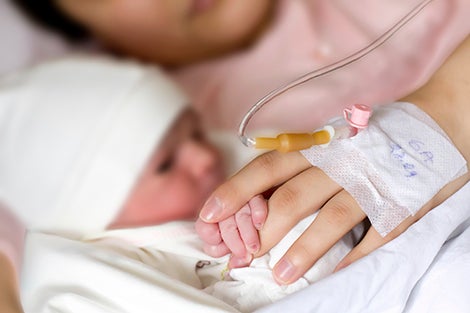For immediate release: July 25, 2016
Boston, MA – Induction of labor appears not to be associated with increased risk of autism spectrum disorders in children in a large new study led by Harvard T.H. Chan School of Public Health. The new finding suggests that concern about autism risk should not factor into clinical decisions about whether or not to induce labor.
The study will be published online July 25, 2016 in JAMA Pediatrics.
Autism spectrum disorders (ASD) —a group of permanent developmental disabilities characterized by impairments in social interaction, language development, and repetitive behaviors—are estimated to affect roughly 1 in 90 children in the U.S.
Labor induction is recommended when labor doesn’t progress on its own and there’s concern that waiting for it to start could endanger the health of the baby or mother. Methods to induce labor include rupturing of membranes, mechanical or pharmacological ripening of the cervix, and administration of oxytocin, either used alone or in combination.
In 2013, a large study in North Carolina found an association between induction of labor and risk of autism in offspring. The report gained widespread media attention, and although both the paper’s authors and other experts cautioned that the association may not be causal, obstetricians began reporting that some of their patients were expressing concern about or opposition to being induced. The Harvard Chan School researchers decided to further explore whether induction of labor truly causes increased risk of neuropsychiatric disorders, in order to help in weighing the risks and benefits of this common therapeutic intervention.
“When we used close relatives, such as siblings or cousins, as the comparison group, we found no association between labor induction and autism risk,” said Anna Sara Oberg, research fellow in the Department of Epidemiology at Harvard Chan School and lead author of the study. “Many of the factors that could lead to both induction of labor and autism are completely or partially shared by siblings—such as maternal characteristics or socioeconomic or genetic factors. Finding no association when comparing siblings suggests that previously observed associations could have been due to some of these familial factors—not the result of induction.”
Working with colleagues from Sweden’s Karolinska Institutet and Karolinska University Hospital, Harvard Medical School, and Indiana University, the Harvard Chan School researchers studied all live births in Sweden from 1992–2005. They followed over 1 million births through 2013, looking for any neuropsychiatric diagnoses and identifying all siblings and maternal first cousins. They also incorporated several measures of the mothers’ health in their analysis.
Nearly 2% of babies in the study population were diagnosed with autism during the follow-up period, the researchers found. Overall, 11% of the deliveries had involved induction of labor, often occurring in conjunction with pregnancy complications such as gestational diabetes, gestational hypertension, and preeclampsia; 23% of the induced pregnancies were post-term.
In their initial comparison of individuals who weren’t related to each other, the researchers found an association between labor induction and ASD risk, similar to that previously reported. But when they compared “induction-discordant” siblings (children born to the same mother—in one, labor was induced, in the other, it wasn’t), they no longer saw an association.
“Overall, these findings should provide reassurance to women who are about to give birth, that having their labor induced will not increase their child’s risk of developing autism spectrum disorders,” said Brian Bateman, anesthesiologist and associate professor of anesthesia at Massachusetts General Hospital and Brigham and Women’s Hospital, Harvard Medical School, and senior author of the study.
“It is important to note that the findings pertain to the risks associated with labor induction per se, and not the specific method or medication used in the process, including oxytocin,” said Oberg.
Sonia Hernández-Díaz, professor of epidemiology at Harvard Chan School, was a co-author of the study. Funding for the study came from grants 2012-34 (International Postdoctoral grant) and 340-2013-5867 (Swedish Initiative for Research on Microdata in the Social and Medical Sciences [SIMSAM]) from the Swedish Research Council and grants K08HD075831 and R01HD061817 from the National Institutes of Health Eunice Kennedy Shriver National Institute of Child Health & Human Development.
“Association of Labor Induction With Offspring Risk of Autism Spectrum Disorders,” Anna Sara Oberg, Brian M. D’Onofrio, Martin E. Rickert, Sonia Hernandez-Diaz, Jeffrey L. Ecker, Catarina Almqvist, Henrik Larsson, Paul Lichtenstein, and Brian T. Bateman, JAMA Pediatrics, online July 25, 2016, doi: 10.1001/jamapediatrics.2016.0965
Visit the Harvard Chan School website for the latest news, press releases, and multimedia offerings.
For more information:
Marge Dwyer
617.432.8416
mhdwyer@hsph.harvard.edu
photo: iStockphoto.com
###
Harvard T.H. Chan School of Public Health brings together dedicated experts from many disciplines to educate new generations of global health leaders and produce powerful ideas that improve the lives and health of people everywhere. As a community of leading scientists, educators, and students, we work together to take innovative ideas from the laboratory to people’s lives—not only making scientific breakthroughs, but also working to change individual behaviors, public policies, and health care practices. Each year, more than 400 faculty members at Harvard Chan School teach 1,000-plus full-time students from around the world and train thousands more through online and executive education courses. Founded in 1913 as the Harvard-MIT School of Health Officers, the School is recognized as America’s oldest professional training program in public health.
